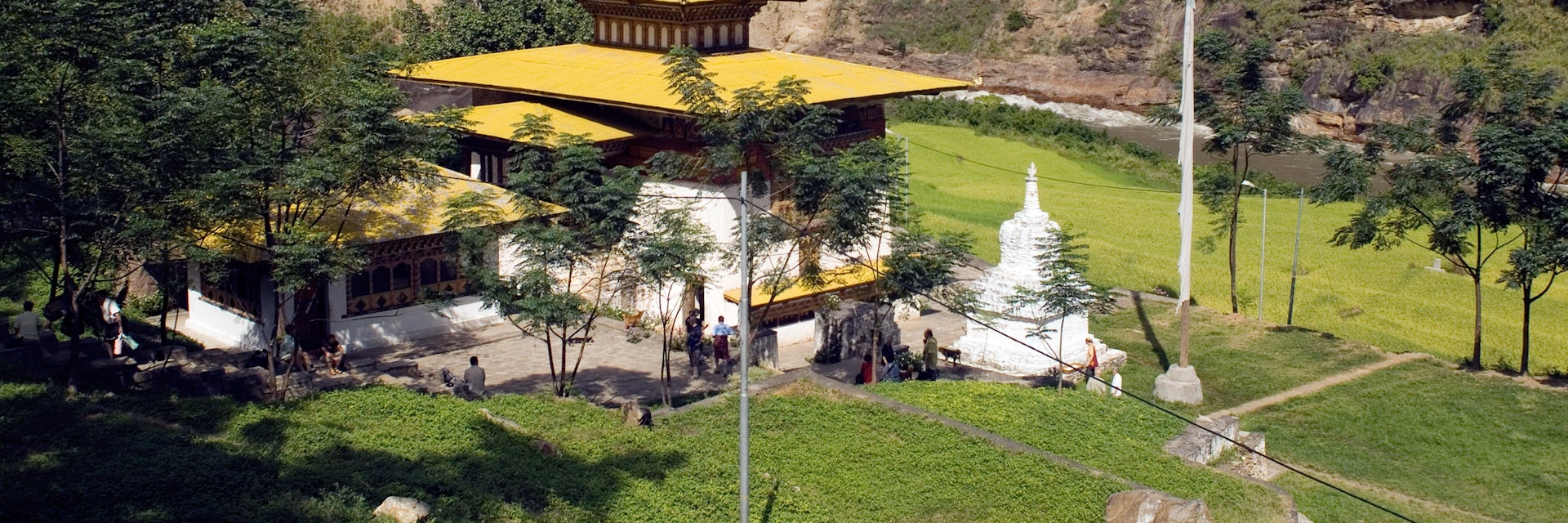An extraordinarily picturesque temple, Gom Kora is located 13km north of Chazam. The lush green fields, the monks' red robes and the temple's yellow roof combine with colourful Buddhist carvings and the rushing river to create an idyllic scene.
The correct name for the site is Gomphu Kora. Gomphu denotes a sacred meditation site of Guru Rinpoche and kora means 'circumambulation'. The Guru meditated here and left a body impression on a rock, similar to that in Kurjey Lhakhang in Bumthang.
The central figure in the temple is Guru Rinpoche. To the right is Chenresig, in his 1000-armed aspect. To the far right is an image of the snake demon Gangan Yonga Choephel, who holds a golden mirror in his right hand. The wall murals to the far right are believed to date from the 15th century.
There are numerous sacred objects locked in a glass cabinet that either miraculously appeared here or were brought by the Guru. The largest item is a garuda egg, which is a very heavy, perfectly shaped, egg-like stone. Other relics include the traditional boot print of the Guru, the footprint of his consort Yeshe Tsogyal (aged eight), the hoof print of Guru Rinpoche's horse and a phallus-shaped rock belonging to Pema Lingpa.
Gom Kora's celebrated old thondrol, unique because it is painted, not appliquéd, is either kept in the box here or in Chorten Kora, depending on which source you believe. Gom Kora has a 'new' thondrol, which is displayed at the tsechu on the 10th day of the second lunar month (March/April). This festival is different from most other tsechus in that pilgrims circumambulate the goemba and sacred rock throughout the night.
Behind the goemba is a fantastical large black rock. It is said that Guru Rinpoche was meditating in a small cave near the bottom of the rock when a demon in the shape of a cobra suddenly appeared. The Guru, alarmed, stood up quickly, leaving the impression of his pointed hat at the top of the cave, and then transformed himself into a garuda, leaving the imprint of his wings nearby. The Guru then made an agreement with the demon to stay away until the end of his meditation. The contract was sealed with thumbprints, which are still visible on the rock. The serpent also left a light-coloured print, with his hood at the top of the rock.
A small sin-testing passageway leads from the cave to an exit to the side of the rock – one successful participant reported that you must indeed move like a snake to get through the cave. Visitors also test their sin levels and rock-climbing skills by trying to climb up the side of the rock (the 'stairway of the dakinis'; female celestial beings) – only the virtuous can make it. On certain auspicious days, holy water, believed to be the Guru's nectar of immortality, flows down from a crevice in the rock and pilgrims line up to spoon it into bottles. You may also see childless women carrying a hefty holy stone around the kora path to boost their chances of conceiving.
Gom Kora has no accommodation, but is only a 45-minute (22km) drive from Trashigang, the best place to eat and sleep in the area. To get here from Trashigang, drive the 9km (15 minutes) to Chazam and take the turn-off towards Trashi Yangtse; after 13km you will see the yellow roof of Gom Kora below the road. There is a parking area but this is woefully inadequate during festival time.


